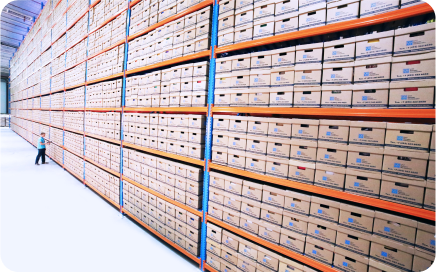Optimize Your Warehouse Management: 7 KPIs You Should Track
By Rackbeat January 15, 2024

The purpose of this post is to present the 7 most important KPIs you must track as a business with an inventory.
Why are KPIs important?
In the following, we will present 7 KPIs, you must keep track of when you are a business with an inventory. However, first we will briefly touch-upon why they are crucial to track, as an inventory driven business. KPIs i.e. Key Performance Indicators, are as the acronym suggests key numbers that help you identify and assess the performance of your company. Key Performance Indicators, and its acronym KPI, will be used interchangeably in this post.
If your company does not have a standardized method of measuring the health of the company, it is difficult to accurately measure progress and/or setbacks, which consequently makes it hard to make the necessary adjustments.
Key Performance Indicators, should be used as just that ; Indicators of how your company is doing compared to both internal (e.g. growth goals) and external factors (e.g. industry standards).
It is your task to determine the “right” numerical value of the KPIs, as this is largely determined by company specific factors, e.g. industry, business model etc.
In the following, we will present 7 fundamental KPIs that can aid in optimizing your warehouse management regardless of your company’s business model..
1) Inventory turnover rate
Keeping track of your inventory turnover rate is important, since it directly reflects the speed and frequency of your sales.
Your company is very likely to have capital tied up in your inventory goods, therefore it is essential to keep track of what type of goods you are selling, how long it takes to sell and what occupies valuable warehouse space.
Be mindful of whether you re-order non-profitable or difficult to sell products. Products and/or goods that do not sell is an expense – not only is it not bringing in cash; it occupies valuable warehouse shelf-place, in addition to reducing warehouse efficiency.
Summing up: Tracking your inventory turnover rate is fundamental, if you aim at maximizing profit and efficiency.
2) Inventory expenses
Keeping your warehouse stocked comes with a multitude of expenses, e.g. labour, risk, insurance, rent, storage space etc. These expenses are typically accounted for at the end of each quartet, depending on the business’ accounting period(s).
Having detailed and accurate insight into inventory expenses, you can predict how much profit your current inventory can generate and how much should be written off.
Furthermore, keeping track of inventory expenses is foundational for better controlling expenses.
3) Goods received
Another important KPI is the efficacy and accuracy of registered received goods.
Inaccuracies in the registration of goods received can rapidly generate a negative domino effect. Potential numbers that are associated with this KPI include warehouse workers’ labor cost associated with handling the goods, time from received to the correct placement, storage requirements, etc.
A way to optimize the receivement process, is to track time spent on handling the Goods received process per. warehouse employee per. hour. Subsequently, this enables you to set realistic targets for your warehouse employees.
Other aspects that are important to keep in mind, when looking at this KPI include;
- Cost per. received line
- % difference between invoiced and received orders
- Order processing time
Equally important is to organize and categorize your goods, in a way that ensures logistical efficiency. This has direct influence on this KPI.
4) Put-away
When your goods are received and registered, storage of the put-away workflows begin. This is a prerequisite for pick, pick and shipping. By streamlining this process, you can ensure frictionless pick-and-pack.
Any positive development of this KPI directly translates into lower shipping time, which has a positive spill-over effect on other workflows.
Measuring the put-away KPI is not always straightforward. However, it is far from impossible.
Consider measuring the following:
- The accuracy of recorded financial values
- Price of goods invoiced and paid, but never received
- Labor hours
- Cost of storage
5) Inventory value
The best way to measure your company’s precision in its warehouse management, is to compare the actual inventory value with the theoretical inventory value i.e. the one recorded on the balance sheet .
If you aim at recording and tracking this KPI, free from counting and data-entry errors, you can use a barcode scanner for stock taking in addition to using a WMS that merges accounting and warehouse data.
If the stock value in the books are not aligned with the factual stock values, you will experience unnecessary high expenses, inaccurate bookkeeping, and lower customer satisfaction.
Manual warehouse management is not only time-consuming: It often results in errors and unnecessary expenses. As an example, many manufacturing companies purchase semi-finished products that they already have in stock due to a lack of real-time insight into their stock value and levels.
You could benefit from researching Warehouse Management Systems, which is compatible with systems you already use e.g. accounting and order fulfillment.
Improving the accuracy of this KPI is an easy way to optimize your company’s purchasing and order handling.
6) Throughput
Throughput refers to the number of units that are processed and moved through your warehouse on a daily basis. To calculate your throughput rate, you should track the movement of goods through the warehouse during a given period. If you want to measure how many orders your warehouse processes within an eight-hour shift, you can monitor the number of orders received during that time period and how long it takes for each product to move from the picking stage to packaging and labeling. If your warehouse processes 400 orders in eight hours, it means that, on average, employees complete 50 orders per hour.
7) Order management
When you begin tracking your operations, you may notice that order management is one of the most demanding operations. It is usually the most complex and demanding task.
Great customer service demands great order management. Therefore, tracking order management KPIs enables you to improve customer service. It is (nearly) impossible to manage something that is not measured: What gets measured gets managed.
As a minimum, you should keep track of the following:
- Cost per. picked order
- Number of orders picked within a timeslot: An average picker is expected to pick between 120-175 pieces/cases per hour. And the most efficient pickers achieve more than 250 picks per hour. The use of advanced technology such as Voice Picking can increase picking speeds by up to 30% under the right conditions.
- The value of labor used on pick & pack
- Use and cost of packaging materials and equipment
- Time from order received to shipment: Consumers increasingly expect an order to be delivered within 1-2 days.
- That is, how well an order or a delivery has been filled with the desired goods in relation to the original request. It is often said that a fill rate of 97-98% is good. If it drops below 94%, one should look into a more efficient reorder process.
Another important KPI could be the percentage of correctly picked orders – the first time.The fastest way to ensure correct pick & pack the first time is to use software that automatizes these processes as much as possible.
If you own a smaller company, these KPIs are even more important to track, since it directly influences your ability to compete against larger companies. If you do not have a clear overview of your company’s key numbers, you do not have a good foundation upon which you can base your decision.
Track your company’s KPIs and gain a better understanding of your entire supply chain, your customers, your workflows, and the overall agility and efficiency of your company.
Are you lacking time, ressources or the desire to crunch numbers? No worries – software can keep track of your company’s KPIs.
Want to Improve Your KPIs? Choose the Right Inventory Management System
If you are looking to boost your KPIs, you need an inventory management system to help you track your order management, inventory value, goods reception and much more.
But choosing any old system won’t do you any good. Quite the contrary. Because if the system can’t meet your business’ specific requirements, then you will just poor money out the window while you try to adapt to a system that doesn’t suit you.
That’s why we have made this free guide for you. It takes you through all the necessary steps you have to walk before you purchase the right inventory management system.
Get it right here, and make the best business decision you’ve made in a while.
Interested in learning more? Sign up to our exclusive content newsletter!
If you found this blog useful, then you should try our monthly content newsletter. You won’t be spammed with the same e-mail over and over, but you will, however, be spammed, once a month, with a heap of insights, knowlegde and blogs on inventory, warehouse, supply chain management – and much more.
Don’t hesitate: sign up to our content newsletter.



